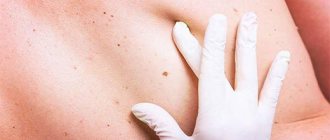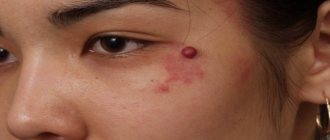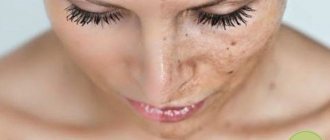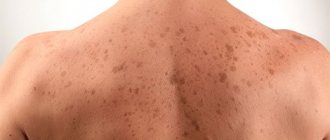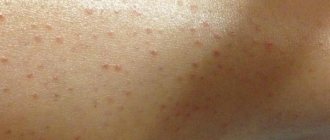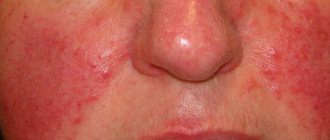What are moles?
Experts distinguish the two most common groups of moles - pigmented and vascular.
There are many classifications of moles, and all of their components have their own medical term or name. But still, experts distinguish the two most common groups - pigmented moles and vascular ones. The former are formed due to an excess of melanin, the latter – due to problems with blood vessels (in particular with capillaries). Moles can also be congenital or acquired. Moreover, congenital ones are not always visible immediately; their pigmentation appears only after some time.
Large moles are the most dangerous, so you need to monitor them constantly and consult a doctor if there is the slightest change. Large formations can quickly transform into malignant tumors, which can negatively affect not only the skin, but also internal organs, and also contribute to the development of various diseases.
Causes of red moles on the body
By its nature, a red mole is a cluster of blood vessels and capillaries
By its nature, a red mole is a cluster of vessels and capillaries, which normally perform the function of oxygen and nutritional supply to the epidermal structures. With the development of any internal pathological process or under the influence of exogenous factors, small vessels can connect, forming a kind of bundle, which in medicine is often called an angioma.
When asked by a patient regarding small red moles, “What is this?”, the specialist will most often answer – angioma. Typically, these pigmented formations are formed during the period of active growth of the body, that is, in early childhood, which is associated with a serious transformation of the human vascular system at this age.
A distinctive feature of red pigmented nevi is the loss of color intensity of the formation when pressing on it, which is associated with a vascular reaction. In addition, red moles normally do not hurt or itch, and do not change their shape and size over time.
The following etiotropic factors may be the causes of angiomas in adult patients::
- Excessive sun exposure (excessive ultraviolet radiation);
- Hormonal imbalance (puberty, pregnancy, menopause, etc.);
- Pathologies of the gastrointestinal tract, especially the pancreas;
- Injuries and mechanical damage to the epidermal integument;
- Diseases of the cardiovascular system;
- Violation of the formation or destruction of pigmented cells.
Today, doctors do not give a clear answer regarding the causes of red moles on the body, however, the factors listed above can become a provoking condition for their appearance.
Causes of red spots
Most often, vascular development disorders occur during embryonic development and occur predominantly in girls. The cause of the occurrence of such neoplasms has not been established for certain, however, according to one hypothesis, their formation is associated with the circulation of estrogen. Therefore, their appearance is much more common in women than in men. Other studies show a connection between the development of red spots and an increased ability to form and grow blood vessels. This applies to the so-called infantile hemangiomas, which appear in infancy and often go away on their own.
As for red dots in adults, doctors associate their appearance with many different reasons, including:
- diseases of the gastrointestinal tract, pancreas;
- cardiovascular diseases and violation of the rheological properties of blood;
- pregnancy and various hormonal imbalances;
- kidney diseases;
- disruption of metabolic processes in the body;
- hereditary predisposition.
Hemangiomas on the scalp under the hair can be injured when combing.
Since small hemangiomas do not cause concern and usually disappear on their own, they do not require separate treatment. Indications for treatment arise when the tumor begins to grow, bleeding or inflammation occurs, and there is a risk of dangerous complications or irreversible disfigurement of the patient. Depending on the size, location and individual health characteristics of a person, hemangiomas can be eliminated using medication, surgery or laser methods.
Types of red moles
Red star-shaped mole
The appearance of red moles on the body can be accompanied by various visual characteristics of the defect. Such epidermal formations can be either flat, forming in the deep dermal layers, or have a superficial nature, protruding above the skin. Moreover, according to the nature of the visual picture, all angiomas are usually divided into two groups:
- Spot. The pigmented area has clear red borders and is a point at which a collection of vessels and capillaries is concentrated. Often, punctate angiomas are multiple in nature, manifesting themselves in the form of specific “rashes” on the patient’s skin.
- Star-shaped. Such moles are a collection of tiny thin vessels that are visible through the epidermis and converge at a central point, forming a kind of star. These structures are also associated with diseases such as rosacea.
In addition, a separate group includes especially large red moles on the body - hemangiomas, which usually significantly spoil the patient’s appearance and require cosmetic correction.
Types of red dots on the body
Red moles of vascular origin are called angiomas. If the cause of such a neoplasm is a defect in the blood vessel, then the mole is called a hemangioma, and if it is lymphatic, then a lymphangioma. While hemangiomas can appear on the body in any area, lymphangiomas are usually localized in areas of greatest concentration of lymph nodes:
- in the mouth,
- on the neck,
- in the armpit area,
- in the groin area.
Hemangiomas themselves, or tumor formations associated with malformation of blood vessels, are most often congenital in nature, and their formation is associated with various pregnancy anomalies. Hemangiomas are divided into superficial and deep. Superficial, as the name implies, are located in the skin and are colored bright red or red-violet. They may appear as flat spots or raised papules of varying shapes or sizes. Such tumors are considered benign and usually do not cause significant discomfort. However, if they are located on the scalp or in the inguinal/perianal areas, these growths may be at risk of ulceration with subsequent infection. In this case, exudate with an unpleasant odor may appear, or the tumor becomes covered with a black or yellow crust and becomes painful and may itch.

Only qualified specialists can choose the correct treatment for red dots
Deep hemangiomas can affect internal organs, most often without causing symptoms. However, damage to such a tumor as a result of trauma leads to profuse and difficult to stop bleeding, which can lead to death. Often, deep hemangiomas can be associated with small superficial capillary neoplasms. In this case, additional diagnostics using ultrasound or MRI will be required.
Red moles in newborns
During the neonatal period and infancy, red moles in children are very noticeable, but they often disappear by the age of 5.
Such benign tumors do not pose a danger if they:
- They do not itch, do not hurt, do not cause any concern;
- They do not become larger, for example, in a few months they do not increase in size by 3 times or more;
- Not located under the eye, on the nose, on the face or on the genitals.
It is known that hemangiomas can rapidly grow along the periphery, this is especially true for the first months of a child’s life. Therefore, in 10-12% of cases they are removed, since there are indications for this.
The fact is that as the mole grows, it will destroy nearby tissues, causing defects not only cosmetic, but also functional. This is relevant in the case when hemangiomas are located on the ears, under the eyes, etc. Normal functioning of organs becomes impossible due to compression by the overgrown formation.
Features of red moles in adults
Red moles, as primary formations, do not appear in adulthood. They arise from previously undetected vascular proliferations. Most often, they are treated before the child enters school, so if a hemangioma is present in adulthood, this means that it was either not treated, or the tumor is located on internal organs.
The most dangerous location of a red mole is considered to be the vertebral body. As the tumor grows, the structures of the spine will weaken, which contributes to the occurrence of fractures.
Prevalence and localization
According to available statistics, hemangiomas are detected immediately after the birth of a child. This happens in 87% of cases. Girls are at risk; they account for about 70% of all diagnosed red moles. By the way, it is hemangiomas that make up up to 48% of all soft tissue formations that are detected in childhood.
A red mole can be found in any part of the body, but 80% of all such defects are localized in the upper part of the body. It is also possible to detect hemangiomas, although extremely rarely, on the bones, in the brain, lungs, and liver.
- 95% of all hemangiomas are simple formations;
- 3% – cavernous formations;
- 2% – mixed type formations.
The most common are red moles on the skin. But angiomas can also be located on the mucous membranes and even in internal organs. Red moles are especially common on the face and neck.
Red moles on the body do not appear so often, but they are also not uncommon. Red moles often appear on the stomach.
Red dots on the body are often discovered at birth or in early childhood, and they increase as the body grows. Small red dots can appear at any age throughout life.
Red moles, or so-called port-wine stains, can be significant in size and cover most of the face, leading to pronounced cosmetic imperfections. But more often there are small formations in the form of small red dots. Red moles on the chest appear more often in women. And in men, red dots most often appear on or near the nose.
Why are red moles dangerous?
Many doctors believe that red moles do not pose any danger, despite the fact that they are benign tumors
Many doctors believe that red moles do not pose any danger, despite the fact that they are benign tumors. For many people, it is simply a matter of beauty and external aesthetics. Of course, red moles cause some concern, but often their owners simply do not notice angiomas on their body and do not attach much importance to their appearance. However, there is an opinion that red moles can directly affect the health of internal organs.
In particular, with diseases of the pancreas and liver, red dots are localized only on the upper part of the body, mostly on the arms. The more intense the localization of red moles, the more the disease worsens. Red moles can also indicate the presence of rheumatic diseases, such as lupus, dermatomyositis or arthritis. But in this case there is no clear location of the angiomas. They can be of various shapes and sizes.
If a red mole does not bother its owner and does not change its external characteristics, it can be argued that such a formation does not pose a significant threat to the health and life of the patient. At the same time, you should get professional medical advice and resort to modern therapeutic methods if you have the following manifestations:
- The red mole grows or changes its shape;
- The patient experiences pain, itching or burning in the area where the pigmented formation is located;
- The mole is bleeding;
- Superficial structures or ulcerations appear;
- There are more than 6 small red dots in one area of the body.
All these symptoms may indicate the development of an oncological process. In addition, the category of dangerous moles includes angiomas located in places where they can be easily injured when wearing clothes, shoes, jewelry, etc. Mechanical damage to such a formation can provoke the appearance of new red moles on the body, activate malignant transformation and leave scars or scars on the skin.
Why red moles appear, diagnosis and consequences
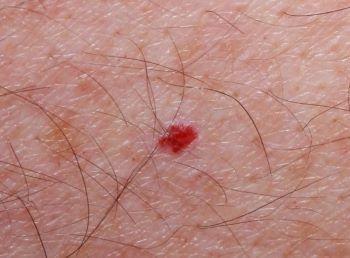
When red moles form on the body, the reasons for their appearance are as follows:
- pancreatic diseases;
- deterioration of blood circulation;
- gastrointestinal pathologies;
- chronic infections;
- heredity;
- pregnancy;
- improper metabolism;
- heart diseases.
Experts also believe that red moles on the body are a signal of dangerous diseases (photos of such moles can be seen in this article). Formations signal pathologies such as lupus erythematosus, Henoch-Schönlein disease, and rheumatoid arthritis. Doctors also believe that red moles may indicate poor blood circulation.
Tumors can become malignant due to damage from clothing, shoes, and jewelry and exposure to direct sunlight for a long time. Unfortunately, red moles can develop into skin cancer.
After the tumor is removed or disappears on its own, a white scar may form in its place. And in children, moles that are located near the eyes and nose can cause impairment of vision and smell.
You cannot remove red moles yourself! This process can lead to heavy bleeding, and the moles themselves will reappear and grow in size.
Usually such formations do not cause much inconvenience. After an examination at a dermatologist’s appointment and a person’s questioning about symptoms and general well-being, additional examinations are sometimes prescribed by a surgeon, endocrinologist, neurologist and other doctors. It depends on the cause of the tumors.
What to do if a red mole appears on the body
An indication for immediate consultation with a doctor is the growth of angioma
Since red moles tend to go away on their own, specialists usually do not prescribe a special course of treatment. If an angioma does not grow and does not bother a person in any way, then it does not pose a danger. It is not recommended to touch neoplasms in closed areas of the body. Removal may be approved by a specialist if the mole is located, for example, on the face, i.e. for cosmetic purposes. An indication for immediate consultation with a doctor is the growth of angioma.
There are several treatment options for red moles, and it should only be chosen by a medical specialist after conducting a series of studies. Among the most popular and effective methods of treating angiomas is laser surgery: vascular sclerosis, X-ray therapy, infrared or light coagulation. Flat red moles are treated much faster and easier than raised ones. The operations are performed without anesthesia, although they are quite unpleasant in sensation. Sometimes after the procedure it is necessary to use a numbing cream. After removal of the angioma, it is recommended to avoid visits to the solarium and prolonged exposure to sunlight for several months.
Complications
Hemangiomas (red moles) can disrupt the functioning of organs that are located next to them. This is especially dangerous if they grow in the liver, near the eyes, or in the brain.
- Inflammation and the appearance of ulcers on the mole are possible. As the pathological process fades, spontaneous disappearance of the mole is not excluded.
- Bleeding from a mole as a result of its traumatization. Bleeding is dangerous if there is a large mole, if it is a cavernous or combined formation localized on the internal organs.
- Infection.
How to get rid of red moles
Removal of small red moles is usually carried out for aesthetic reasons. If red dots on the hands rarely bother you, then a red dot on the face does not look aesthetically pleasing and attracts attention. Treatment for red moles involves removing them.
Removing red moles is not difficult, but the procedure must be carried out only in a clinic equipped with modern high-quality equipment.
And, most importantly, the removal of the tumor should be carried out by a dermato-oncologist. He will be able not only to correctly diagnose, but also to carefully rid you of red moles and dots.
Diagnostics
If you find a red mole on your body, most importantly, do not be afraid, since nothing serious has happened and no treatment is required. You will need to do the following:
- If moles appear in large numbers in the chest area , consult a doctor. One or two are not particularly significant, but the unexpected appearance of more may be a sign of existing health problems.
Read the continuation on the next page by clicking its number below.
Medical correction of red moles
The doctor, after conducting an initial examination and the necessary diagnostic measures, will make a conclusion regarding the likelihood of malignancy of the red mole. Based on this diagnosis, a strategy for further therapeutic actions is developed. If a red mole does not pose an oncological threat and is located in a closed area of the body, its removal is not necessary.
In cases where the red nevus causes aesthetic or physiological discomfort to the patient, it can be removed using modern hardware techniques, the priority among which is laser destruction.
This method of removing red moles guarantees painlessness and safety for the patient, and also has a low level of trauma.
Multiple and small formations
The appearance of red moles on the body of adults is provoked due to hormonal changes that occur throughout life. Neoplasms and their manifestations indicate diseases of the digestive system.
It is recommended to consult a doctor who should prescribe preventive measures. It happens that the anxiety state turns out to be false.
It is better to prepare in advance and take preventive action than to treat a more advanced form of pathological formations later.
Multiple small skin formations can appear due to improper functioning of the heart and circulatory system. The influence of improper functioning of pigment cells cannot be excluded.
So, how to remove a red mole
The least traumatic and most effective method is the removal of red moles using the Surgitron radio wave device
The least traumatic and most effective method is removal using the Surgitron radio wave device. Using the radio wave method is the best choice for removing red spots and moles on the face and other open areas of the body, since the surrounding tissues are not injured. After healing, as a rule, no trace remains. Using the Surgitron radio wave device (made in the USA), it is possible to remove red dots without leaving a trace, since the radio wave does not damage surrounding tissues. If you are deciding where to remove a red mole in Moscow, pay attention to the method that the clinic offers and the qualifications of the doctors.
What do red moles on the skin mean? How dangerous are they?
Most likely, you may also have noticed the presence of red dots on your body that look like moles.
Very often they are small in size and purple in color (sometimes slightly lighter), often appearing on the neck, chest and back. But what is the reason for the occurrence?
Are they dangerous, and do they need to be monitored? We will try to answer these and other questions related to red moles in today’s article.
Small scarlet spots that suddenly appear on our body make us scared and anxious.
They don’t hurt, but they don’t look particularly aesthetically pleasing, and, most importantly, we constantly ask ourselves why they appeared so unexpectedly? Maybe the reason lies in our diet? Or is this a symptom of some disease?
To reassure you, we’ll immediately say that this is not that serious , although yes, any changes that occur to the skin should be monitored. But let's take a closer look.
For what reason do red moles appear on the body?
Some people find their moles very attractive. However, in most cases they represent a change in skin pigmentation that needs to be monitored.
The scientific name for the red spots we are talking about today is red nevus or angioma. As a rule, they appear in people with fair skin or in middle age.
As we mentioned earlier, they do not pose a health hazard, but if they appear frequently and in large quantities, then this is a reason to consult a doctor, because, without a doubt, this is a signal that some changes are taking place in our body.
See also: The condition of the neck can indicate dangerous diseases - doctors
Typically, experts in this field associate the appearance of red moles with problems with the liver, or, to be more precise, with its not entirely correct functioning.
They can also appear due to poor nutrition , when many toxins . Their appearance is provoked by abnormal growth of blood vessels .
The size of red moles ranges from 1 to 4 mm . They can be located in the armpits, genitals, heels, chest, back, arms, legs...
Red spots on the face, hands and other exposed areas of the body that are rarely covered by clothing may appear due to excessive sun exposure . You should be more careful.
Pay attention to the edges of these moles and their texture. If they are uneven, rough and exceed 6 mm in size, then you should consult a dermatologist.
Take a closer look at the smallest inhabitants of your family; children with very fair skin may also develop such red dots on their bodies.
Therefore, you should check your children regularly to keep the situation under control. Very often the appearance of such moles is hereditary.
Another reason for their appearance on the body may be minor hormonal changes in women. And finally, they can appear trivially with age.
Diagnostics
If you find a red mole on your body, most importantly, do not be afraid, since nothing serious has happened and no treatment is required. You will need to do the following:
See also: This guy did 7 exercises every day for 1 month. Back pain disappeared without a trace!
If moles appear in large numbers in the chest area , consult a doctor. One or two are not particularly significant, but the unexpected appearance of more may be a sign of existing health problems.
Check what shape your moles have, whether they are symmetrical or asymmetrical. If the latter, consult a doctor.
Pay attention to their shade. If they are red, then there is no problem, but if they gradually darken and become darker and darker each time, then you should notify your doctor.
Treatment and prevention
Experts say that to prevent the appearance of red moles on the body, it is necessary to regularly cleanse the intestines and strengthen the liver. Try to drink at least two liters of water per day.
Try to eat more fresh vegetables and drink natural juices. Carrots, artichokes and celery will be very useful in this regard.
Spirulina algae , for example, perfectly absorb toxins accumulated in the intestines. Include olive oil and avocado in your diet.
Start your morning with a glass of lemon juice. Try to drink at least two glasses of juice a day (preferably cranberry, pineapple, pomegranate...).

Avoid consuming dairy products (you can replace them with plant-based milk). dandelion infusion once a day , this is an excellent cleanser for the body.
To avoid the appearance of red moles, ideally, in addition to eating a balanced diet, you should also protect yourself from the negative effects of sunlight .
See also: JUST RUBB YOUR EAR WITH BENEFIT!
After all, sunscreen may well prevent the appearance of such moles on the face and neck area.
In general, try to always keep your skin well hydrated, consume enough vitamin C and avoid exposure to the sun between 12 and 4 pm.
As a rule, red moles, once they appear on the body, do not disappear on their own. If they really bother you, then you can resort to natural remedies to get rid of them, for example, apply onion juice every day until the moles disappear. Another option is to take a vitamin C tablet (also regularly).
But be that as it may, it is always better to prevent the appearance of red moles by following a balanced diet that will not allow a large number of toxins and harmful substances to accumulate in the body. And then your skin will thank you!
Source
Treatment of red moles
Most red moles do not require treatment and go away on their own. If a mole does not interfere, does not increase in size and does not bother its owner in any way, it does not have a negative effect on the human body and is completely harmless. Experts do not recommend removing red moles that appear on closed areas of the body. The situation is different with those moles that are localized, for example, on the face and spoil a person’s appearance. Rapid growth and change in color of a mole requires immediate contact with a specialist.
There are several ways to treat red moles. It should be noted right away that the cauterization method is not suitable for removing moles.
A mole is most often located in the deep layers of the skin; only its upper part is on the surface. If, after removing a mole, its roots remain in the skin, it may reappear in the same place. The optimal treatment method is prescribed by the doctor after examining the mole for the presence of benign cells. Most often, laser surgery is used to get rid of a red mole.
The most modern methods for removing red moles are light or infrared coagulation of blood vessels, sclerosis of the vascular bed and radiotherapy treatment. Flat moles can be treated faster than those that rise above the skin. During the removal procedure, a numbing cream may be used if necessary. Anesthesia is usually not required in most cases.
It should be remembered that the procedure for removing a mole is very unpleasant and requires some investment. After it is carried out, small reddish spots appear at the site of the removed moles. After some time they disappear completely. After removing a red mole, it is recommended to refrain from visiting a solarium and prolonged exposure to the sun for at least one month.
Therapy of formations
Doctors usually do not prescribe any treatment for red moles because they often disappear on their own. There is no need for therapy if the formation does not become larger and does not bother its owner.
It is not advisable to operate on tumors located on a closed part of the body. Surgery is recommended if they are located on exposed parts, such as the face. Modern medicine offers many options for treating growths. The method is selected depending on the location of the mole and its type.
- Surgical method. The operation is performed in a hospital setting; hospitalization is not required. The surgeon performs an excision, which may leave scars. This surgery is usually performed to remove small growths and is not used to remove facial lesions.
A safe and very effective method that does not leave marks on the skin. It is performed by coagulation method or using liquid nitrogen. Typically, this operation is performed to remove large capillary formations under local anesthesia.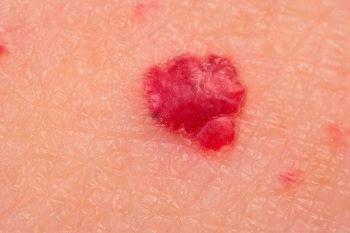
Cauterization.- Laser therapy. The most popular type of surgery to remove tumors. It is done layer by layer, removing tumors located at any depth. The operation lasts about a minute. After it, a crust appears at the site of the mole, which disappears after a couple of weeks.
- Chemical sclerosis. Drugs are injected into the skin around the mole to block the vessels of the tumor and separate it from the bloodstream. It begins to shrink and disappears.
Before removing growths, it is advisable to undergo diagnostics to exclude the possibility of oncology. Only after this the doctor will select the best option for removing the formation. After the operation, you should not stay in the sun for a long time for two months, or visit the sauna or solarium.
Often problems such as various tumors on the body, and especially on the face, become the cause of depression. This is especially true for women who worry about their appearance. We recommend reading about how to get rid of depression on your own.
Spontaneous problem resolution
Red moles go away on their own if they are superficial or simple. This is possible in no more than 15% of cases. Most often, formations that are localized on closed parts of the body regress.
At first, the tumor becomes less bright and decreases in size. After six months, the mole becomes a pale pink spot located at skin level. In this case, the skin over it atrophies. After another 3-4 years, only a small depigmented area remains on the skin.
Sources:
- www.neo-med.biz/articles/krasnyie-rodinki-na-tele.html
- https://boleznikogi.com/ot-chego-poyavlyayutsya-krasnye-rodinki
- https://lechenie-simptomy.ru/krasnye-rodinki-na-tele
- https://udalenie.klem-clinic.ru/angioma
- https://www.ayzdorov.ru/lechenie_pigmentnie_pyatna_krasnie-_rodinki.php
